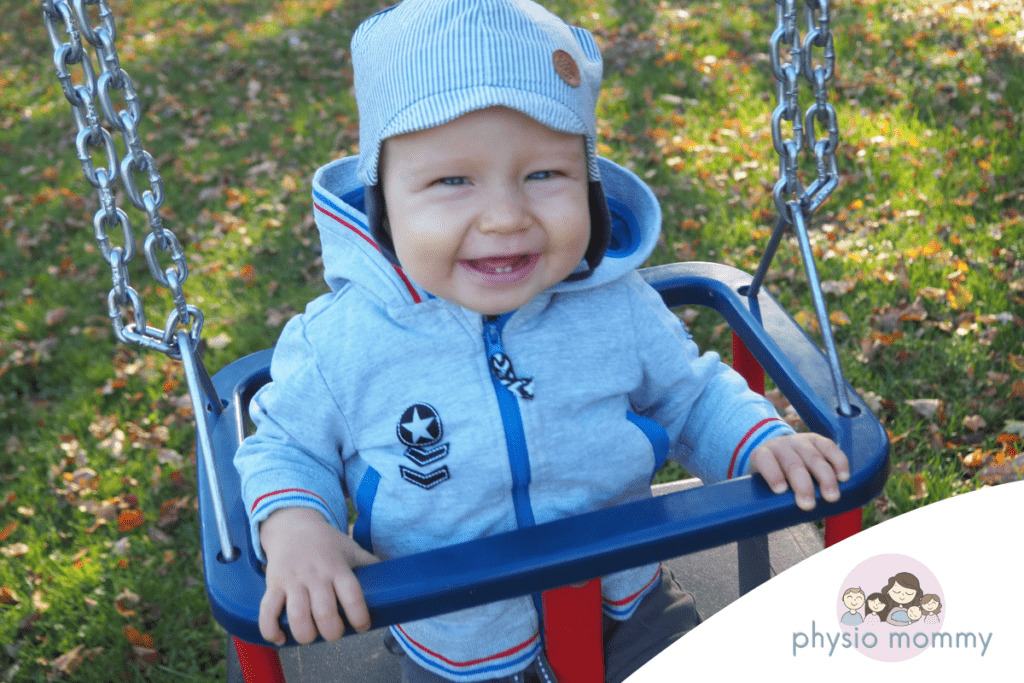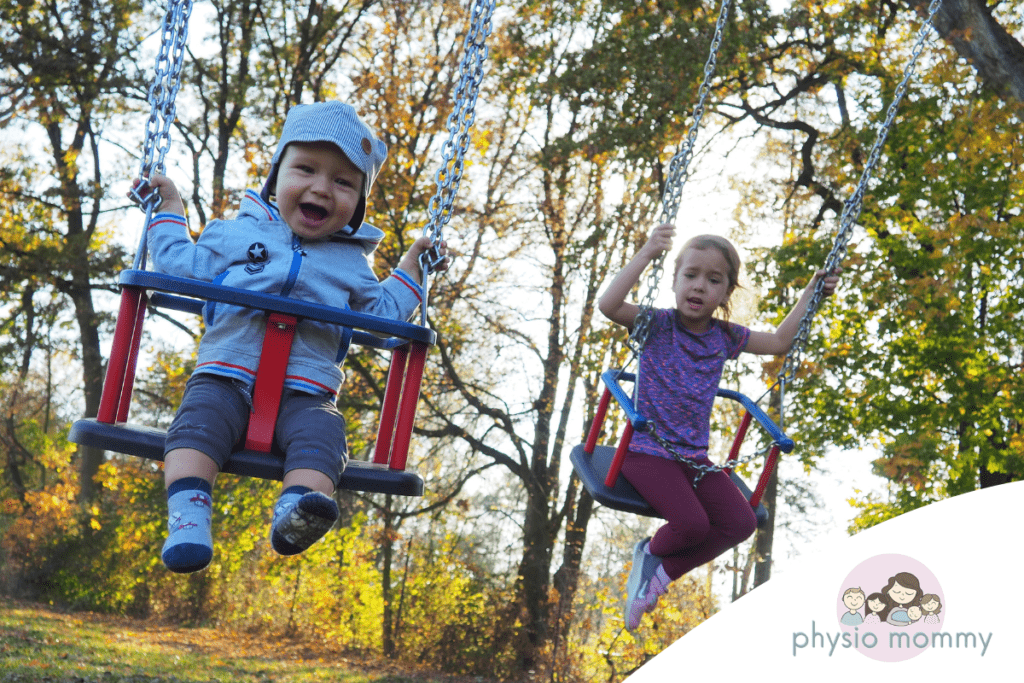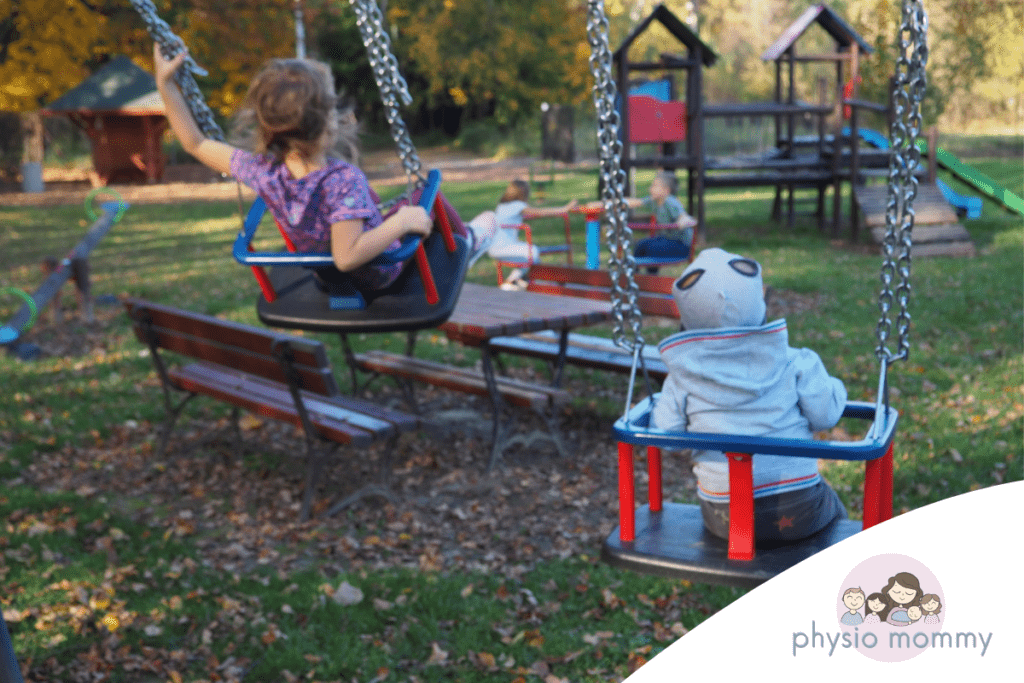When I was a little girl, I really enjoyed spending time on the swing. Whether at home or at the playground, swinging was something I didn’t need to be persuaded to do.
Although I tended to shy away from situations where somebody else would make my swing move too high, when I was the one in control, I felt safe and comfortable.

Swinging on a swing can be really fun. But when to start? What kind of swing to choose for a small baby? And is it a good option for all children?
That’s what you’ll find out in this entry!
WHY CAN ROCKING, SWINGING AND SWAYING BE SO MUCH FUN?
When your baby is restless, you usually take him or her in your arms, carry them or sit with them in a rocking chair or on a gym ball, rock them, and after a while, you notice that the child begins to calm down.
No wonder! Swaying in your arms is an excellent stimulation for the vestibular system – it’s something quite natural for the baby. If your pregnancy went smoothly, your little one remembers this kind of movement from the time when he or she stayed safely curled up in your belly.

Every activity of the baby – whether it comes from their own initiative or is experienced during daily care and play – is a great opportunity to stimulate the vestibular system.
Gentle, monotonous rocking or swaying is something calming, soothing… It helps regulate states of arousal, gives a sense of security and stimulates the oh-so-important vestibular system, which is responsible not only for maintaining balance. Thanks to integration with other senses, it affects muscle tension and activity levels. It is also vital for maintaining a constant field of vision and perception of space, which directly translates into later academic performance of the child (babies who have difficulty with space perception may have problems with writing, distinguishing similar-looking letters or numbers), as well as their social interactions or emotions.
There is no doubt that rocking, swinging and swaying movement is beneficial.
Newborns and infants naturally provide themselves with a dose of good stimulation not only by demanding to be rocked in their parent’s arms, but also by experimenting with movement.
Every turn of the head, every attempt to lift it above the ground, every movement experience is an opportunity for vestibular stimulation, exploring and learning how to function efficiently under the force of gravity.
The advantages of vestibular stimulation may lead to one conclusion – a swing can be a very cool proposition for a toddler! Just… which one to choose? And when is it safe to start using one?
WHICH SWING TO CHOOSE AND FROM WHEN CAN A BABY USE IT SAFELY?
In fact, the best time to start the swing adventure is when a baby starts to assume a sitting position on their own and is able to maintain a good quality sit for a long time.
Why only then? Because swinging is a challenge and the little one, in addition to having to keep their body upright against the force of gravity, will be doing so when the swing is moving.

Does this mean that younger children can’t use any equipment like this and are somehow “robbed” of the opportunity for such great fun? Of course not! Younger babies primarily benefit from being rocked in their parent’s arms (this is an irreplaceable safe space for them!) as well as from all kinds of movement, which helps them develop in many ways! And if we want to give our arms and shoulders a little break, we can put our baby in a cradle suspended from the ceiling, where he or she will lie safely on a relatively hard, flat surface.😊
WHAT SWINGS DO I RECOMMEND?
- First of all, those that support the active sit. In the active sit, the baby’s back is straight and the weight of the body rests on their bottom.
- Are hammocks a good idea? Although hammocks look appealing (well, who doesn’t like lying in a hammock?😊), I’m a big fan of classic wooden swings. Why? Because it is definitely more difficult to change positions in a hammock. Some models make the baby bend their body too much. What’s more, squeezing the chest and tummy together as well as pulling the chin close to the sternum can make it harder to breathe.
- What about cocoon-type swings? As a physiotherapist, I like them a lot. In addition to providing a dose of positive stimulation, they often help the baby to calm down, feel safer and experience some boundaries… However, when hanging this type of swing at your place, remember that your baby’s feet should touch the ground and that he or she should never sleep in this type of equipment.

IS IT WORTH BUYING A BABY SWING FOR THE HOUSE?
If it doesn’t replace the activities on the mat, then yes! Especially for winter seasons, when going to the playground is not as frequent as in the summertime…
Also, every moment of relief for parent’s arms can be of great value. 😊
IS A SWING A GOOD PROPOSITION FOR ALL CHILDREN?
It may surprise you but… not really. There is a group of toddlers who don’t want to get on a swing, and they don’t seem thrilled at all that someone would try to stimulate their vestibular system in a way that is beyond their control.
Very often, they are toddlers who feel the so-called gravitational insecurity.
Such children can be downright panicky about motor activities, especially those over which they have no control and those in which their heads tilt back or their feet pull away from the ground.
Although physically they don’t need any support and very rarely fall down, they may demand almost constant hand-holding and assistance, as these give them a sense of security.
Walking down stairs, getting into an elevator, jumping up, tumbling over, taking a ride on a merry-go-round, swinging on a swing or playing games where someone else might accidentally bump into them are all anxiety-provoking things for such children.
- WHERE DOES THIS FEAR COME FROM?
Most often, from the lack of security.
The main source of a sense of security for each of us is a safe relationship with gravity – finding ourselves under its force.
We actually learn it from the very beginning. With every movement we make, we experience that the force of gravity that acts on our body is something constant. A constant, therefore safe. Something we learn to live with and take for granted.
When our nervous system has difficulty modulating the vestibular stimuli that reach it, we can, for example, feel danger in a situation where it doesn’t really exist.
Simply put, in this case – a small stimulus triggers an exaggerated response.
A child suffering from gravitational insecurity can easily accept activities he or she is familiar with, but any novelty or unpredictability can cause anxiety.
- DO ADULTS UNDERSTAND THIS FEAR?
Unfortunately, very rarely. Sometimes we try to forcefully push certain activities, because we think they are fun for our baby and perhaps ALL children like them…
But think for a moment… If stepping off the curb was a bunjee-jumping-like experience for you, would you find it uplifting if someone ignored or denied what you were experiencing? Would your self-esteem be high?
That’s why, it’s worth remembering that children who experience gravitational insecurity really need wise support. They need understanding.
WHAT CAN WE DO?
- If we suspect our child is struggling with gravitational insecurity, it is best to consult with a sensory integration specialist. If therapeutic support will be needed, it is worth approaching it with calmness. Therapy is very often much more pleasant than we can imagine.
- It is certainly not good to force the child to take up activities he or she fears with the hope that they will eventually get used to them. It’s better if it’s the child’s decision if they’re ready to give it a try.
- If we’re talking about swinging, to start with, you can swing with your baby in your arms, or if you want him or her to do it on their own, hang the swing at a height where the child’s feet can touch the ground.

Children with gravitational insecurity may also find it helpful to play all kinds of games concerning strength: pushing a box of toys, “wrestling” with a parent or carrying heavier objects. Why? Because they allow the child to get a better sense of their body and stand on the ground more confidently.
SUMMARY:
- Swings should be used only after the baby learns to sit.
- It’s good if we choose a swing that supports the active sit.
- A swing should not replace the activities on the mat.
- It’s important to carefully watch the baby and their reactions to the swing.
Interesting fact:
- Stimulation of the vestibular system is important even as early as in the mother’s belly. This is why women who spend their pregnancy lying down for various reasons are advised to lie down in a hammock or a rocking chair.
The content herein is for informational purposes only and will not replace a visit to a physiotherapist or other specialist. If in doubt, please consult with a professional who can examine your baby in person. For the sake of your baby, I do not provide online advice.
For great ideas for spending time and playing with your baby, check out my E-book:
Sources:
- A. Jean Ayres. Sensory Integration and the Child, 2005.
- Goddard Blythe S. The Well Balanced Child, 2005.
Sharing my content with your friends would mean the world to me. Thank you! ❤️